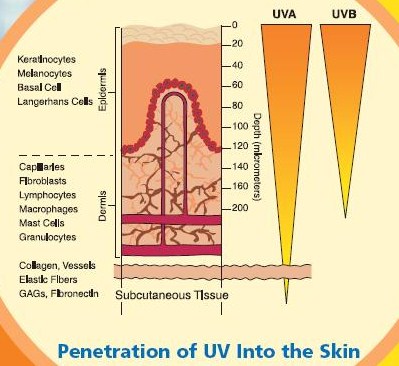How Does UV Radiation Affect My Skin? What Are the Risks? UV rays are divided into 3 groups by wavelengths: UVA, UVB, and UVC. The ozone layer filters out the UVC and many of the UVB rays, but the ozone layer is not the same as it used to be and seems to have little or no effect on UVA rays which make up 90% or more of the sun’s radiation that reaches the earth.
UV radiation, a known carcinogen, can have a number of harmful effects on the skin. The two types of UV radiation that can affect the skin—UVA and UVB—have both been linked to skin cancer and a weakening of the immune system. They also contribute to premature aging of the skin and cataracts (a condition that impairs eyesight), and cause skin color changes -hyperpigmentation. Up to 90% of the visible skin changes commonly attributed to aging are caused by sun exposure. Years of exposure to the sun cause “photoaging,” which includes freckles, yellowing, roughness, visible blood vessels and dark spots, as well as wrinkling.
The electromagnetic spectrum of ultraviolet light can be subdivided in a number of ways. The draft ISO standard on determining solar irradiances (ISO-DIS-21348) describes the following ranges:
| Name | Abbreviation | Wavelength range |
|---|---|---|
| Ultraviolet A, long wave, or black light | UVA | 400 nm–320 nm |
| Near | NUV | 400 nm–300 nm |
| Ultraviolet B or medium wave | UVB | 320 nm–280 nm |
| Middle | MUV | 300 nm–200 nm |
| Ultraviolet C, short wave, or germicidal | UVC | 280 nm–100 nm |
| Far | FUV | 200 nm–122 nm |
| Vacuum | VUV | 200 nm–10 nm |
| Extreme | EUV | 121 nm–10 nm |
UVA Rays, which are not absorbed by the ozone layer, penetrate deep into the skin and heavily contribute to premature aging. Skin cancer typically occurs in skin that is photo-aged. While UVA radiation does not produce any visible short-term evidence of skin damage. Nonetheless, UVA radiation creates serious cumulative changes in skin that may be far greater than the sunburn caused by UVB radiation. Research has shown that unprotected exposure to UVA rays can, within one week, create distinct injury, such as inflammation, abnormal cell production, thickening of the stratum corneum (outer layer of skin), depletion of immune-stimulating cells, and evidence of the possibility of elastin deterioration. UVA is responsible for most of the photo-aging damage. the premature wrinkles, loss of elasticity, sagging (laxity), hyperpigmentation, and a dry, dull, leathery skin texture.
UVB Rays are powerful rays even though they are partially absorbed by the ozone layer. UVB, which is most intense from 10 a.m.-2 p.m., mostly affect the surface of the skin and are the primary cause of sunburn. It can cause basal-cell cancers of the skin as well as the increased risk of melanomas. Because of the thinning of the ozone layer, the effects of UVB radiation will pose an increased threat.

Wrinkles, laxity (sagging skin), uneven pigmentation (age spot, liver spot), brown spots, and a leathery appearance, loss of skin tone and resilience characterize photo-aged skin. In contrast, chronologically aged skin that has been protected from the sun is relatively smooth and unblemished, although has reduced elasticity. Photo-aged skin displays prominent changes in the cellular component and the extracellular matrix (collagen and elastin) of the connective tissue.
Photo-aging (UVA) damages collagen and elastin, the two proteins that give skin its elasticity. (These proteins decline as we naturally age, along with the fibroblast cells that manufacture them.) UV exposure results in an accumulation of disorganized elastin and a severe loss of collagens may be due to the reduced ability in fibroblast growth and collagen synthesis and elevated levels of collagen degrading skin enzyme metalloproteinase as what occurs in the naturally aged.. The enzyme metalloproteinase that break down collagen and elastin increase.
Other changes occur in keratinocytes, upper-layer skin cells that are shed and renewed regularly. In the normal aging process the turnover of keratinocytes slows down and in photo-aging they are damaged.
Still other skin cells, melanocytes, are also affected by both processes: they decline with normal aging and are killed in photo-aging. Stopped in their tracks by sunlight, these normally migratory cells show up as freckles in light skin.
UV radiation also trigger the generation of free radical – one of the main causes of aging –can not only crosslinking collagen directly, it also causes messenger molecules in skin cells to become active and induce inflammation, which is another main causes of aging too. The induced inflammatory molecules will lead to sustained elevations of inflammatory enzymes that degrade skin collagen.